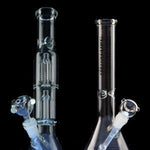Glassblowing is an ancient art form that has blossomed recently into a modern and technically intensive way to create amazing tools and breathtaking art as smoking accessories.
There are countless different techniques out there when it comes to blowing glass but the tools used by glass smiths have remained basically unchanged for centuries. All modern glassblowing workshops are built around three very important furnaces:
The first furnace, oftentimes referred to by glassblowers just as “The Furnace,” is fitted with a container filled with molten clear glass known as a crucible.
The second furnace that is required for glassblowing been lovingly referred to by industry enthusiasts as “The Glory Hole.” This furnace has been specialized to include a small hole on one side where pieces that are in the middle of being blown can be inserted to quickly raise the temperature of the glass. The artist is constantly traveling back and forth from the glory hole to other parts of the workshop to ensure that the glass being blown stays at the correct temperature for blowing.
The third furnace used in glassblowing is called an annealer, or lehr. This specialized furnace is used to lower the temperature gradually of glass that has been worked by a glassblower. The process of slowly letting glass cool helps prevent the problems that come from heat stress like cracking or shattering.
To begin the process of blowing a piece of glass, the artist would dip a long hollow tube made of steel into the crucible and pull out a glob of the molten glass. The molten glass attached to the tube is then rolled onto a flat steel table to straighten out the glass and to begin forming the general shape that the piece will eventually be. The artist can begin to blow through the tube and start inflating the “bubble” of glass, eventually forming a finished piece of glass.
There are many techniques that glassblowers use to add flair to their pieces to give the finished product more appeal. Heating up gold and silver and capturing the resulting fumes in the piece being blown that gives clear glass a semi-opaque backing is a process called “fuming” and is used to give glass a shiny, colorful appearance.
Pigments and metallic compounds can be added to the manufacturing process to create glass with striking color that is highly sought after by glass artists. The addition of special effects is usually a very expensive process, especially using raw artisanally crafted colored glass like Slyme glass, which has an opaque and vibrant appearance or Illuminati glass which glows under ultraviolet light. Because of how expensive the raw glass is, these fancy colors are usually reserved for higher-end brands and require an extremely skilled artist to incorporate them into a piece.
Blowing glass properly takes a very high amount of patience and skill but unfortunately not every glassmaker goes through all the steps it takes to create an aesthetically pleasing piece that is also durable and will not crack from regular use.
To save money some companies have started cutting corners when it comes to colored glass. Some shoddily made pieces are made using a method of adding color to their glass by adding a layer of paint under the top layer of glass. Shortcuts like not using quality ingredients and adding color to glass in unethical ways will lead to a piece that probably will not last nearly as long as glass that has been properly manufactured.
To avoid being disappointed in your next glass purchase, it is very important to buy from a reputable retailer that is honest about their products!






















































